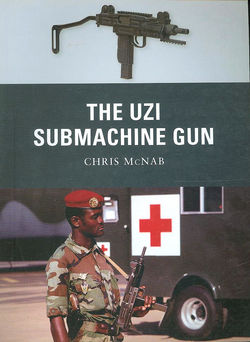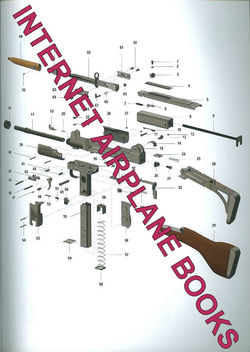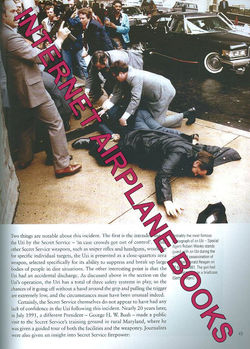OSPREY
WEAPONS 12 UZI SUBMACHINE GUN SMG ISRAELI DEFENSE FORCES SECRET SERVICE COMBAT
SOFTBOUND BOOK BY CHRIS McNAB (80 PAGES)
------------------------------------------------------------------------------------------------------------
Additional Information from Internet Encyclopedia
The Uzi is a family of Israeli open-bolt, blowback-operated
submachine guns. Smaller variants are considered to be machine pistols. The Uzi
was one of the first weapons to use a telescoping bolt design which allows the magazine
to be housed in the pistol grip for a shorter weapon.
The first Uzi
submachine gun was designed by Major Uziel Gal in the late 1940s. The prototype
was finished in 1950. First introduced to IDF special forces in 1954, the
weapon was placed into general issue two years later. The Uzi has found use as
a personal defense weapon by rear-echelon troops, officers, artillery troops
and tankers, as well as a frontline weapon by elite light infantry assault
forces.
The Uzi has been
exported to over 90 countries. Over its service lifetime, it has been
manufactured by Israel Military Industries, FN Herstal, and other
manufacturers. From the 1960s through the 1980s, more Uzi submachine guns were
sold to more military, law enforcement and security markets than any other
submachine gun ever made.
The Uzi uses an open-bolt,
blowback-operated design, technology quite similar to the Japanese Experimental
Model 2 submachine gun series and the Jaroslav Hole�ek-designed Czech ZK 476
(prototype only) and the production Sa 23, Sa 24, Sa 25, and Sa 26 series of
submachineguns. The open bolt design exposes the breech end of the barrel, and
improves cooling during periods of continuous fire. However, it means that
since the bolt is held to the rear when cocked, the receiver is more
susceptible to contamination from sand and dirt. It uses a telescoping bolt
design, in which the bolt wraps around the breech end of the barrel. This
allows the barrel to be moved far back into the receiver and the magazine to be
housed in the pistol grip, allowing for a heavier, slower-firing bolt in a
shorter, better-balanced weapon.
The weapon is
constructed primarily from stamped sheet metal, making it less expensive per
unit to manufacture than an equivalent design machined from forgings. With
relatively few moving parts, the Uzi is easy to strip for maintenance or
repair. The magazine is housed within the pistol grip, allowing for intuitive
and easy reloading in dark or difficult conditions, under the principle of
"hand finds hand". The pistol grip is fitted with a grip safety,
making it difficult to fire accidentally. However, the protruding vertical
magazine makes the gun awkward to fire when prone. The Uzi features a bayonet
lug.
The Uzi submachine
gun was designed by Captain (later Major) Uziel Gal of the Israel Defense
Forces (IDF) following the 1948 Arab-Israeli War. The weapon was submitted to
the Israeli Army for evaluation and won out over more conventional designs due
to its simplicity and economy of manufacture. Gal did not want the weapon to be
named after him, but his request was ignored. The Uzi was officially adopted in
1951. First introduced to IDF special forces in 1954, the weapon was placed
into general issue two years later. The first Uzis were equipped with a short,
fixed wooden buttstock, and this is the version that initially saw combat
during the 1956 Suez Campaign. Later models would be equipped with a folding
metal stock.
The Uzi was used
as a personal defense weapon by rear-echelon troops, officers, artillery troops
and tankers, as well as a frontline weapon by elite light infantry assault
forces. The Uzi's compact size and firepower proved instrumental in clearing
Syrian bunkers and Jordanian defensive positions during the 1967 Six-Day War.
Though the weapon was phased out of frontline IDF service in the 1980s, some
Uzis and Uzi variants were still used by a few IDF units until December 2003,
when the IDF announced that it was retiring the Uzi from all IDF forces. It was
subsequently replaced by the fully automatic Micro Tavor.
In general, the
Uzi was a reliable weapon in military service. However, even the Uzi fell
victim to extreme conditions of sand and dust. During the Sinai Campaign of the
Yom Kippur War, IDF Army units reaching the Suez Canal reported that of all
their small arms, only the 7.62 mm FN MAG machine gun was still in
operation.
The Uzi proved
especially useful for mechanized infantry needing a compact weapon, and for
infantry units clearing bunkers and other confined spaces. However, its limited
range and accuracy in automatic fire (approximately 50m) could be disconcerting
when encountering enemy forces armed with longer-range small arms, and heavier
support weapons could not always substitute for a longer-ranged individual
weapon. These failings eventually caused the phasing out of the Uzi from IDF
front-line assault units.
The Uzi has been
used in various conflicts outside Israel and the Middle East during the 1960s
and 1970s. Quantities of 9 mm Uzi submachine guns were used by Portuguese
cavalry, police, and security forces during the Portuguese Colonial Wars in
Africa.
The Royal
Netherlands Army (Koninklijke
Landmacht) first issued the Uzi in 1956. It was the first country other
than Israel to use it as a service weapon. Their models are distinct in that
they have a wooden stock made to their specifications that is more angular, had
an angled butt and a curved comb, and is 2 inches longer than the IDF model.
The German
Bundeswehr (especially its tank crews) used the Uzi since 1959 under the
designation MP2. It replaced the MP1 (Beretta M1938/49) and Thompson M1 in
service. The MP2 was fitted with the IDF-style wooden stock and the later MP2A1
was fitted with the metal folding stock. It can be recognized by its
distinctive three-position "DES" selector switch: "S"
stands for "Sicher"
("secure", or "safe"), "E" stands for "Einzelfeuer"
("single-fire", or "semi-automatic"), and "D"
stands for "Dauerfeuer"
("continuous-fire", or "automatic"). The Bundeswehr
relegated it to reserve use after adopting the Heckler & Koch MP5 in 1985.
It was replaced with the Heckler & Koch MP7 Personal Defense Weapon in
2007.
The United States
Secret Service used the Uzi as their standard submachine gun from the 1960s
until the early 1990s, when it was phased out and replaced with the Heckler
& Koch MP5 and FN P90. When President Ronald Reagan was shot on March 30,
1981 outside of the Washington Hilton Hotel by John Hinckley, Jr., Secret
Service Special Agent Robert Wanko pulled an Uzi out of a briefcase and covered
the rear of the presidential limousine as it sped to safety with the wounded
president inside.
The Uzi Submachine Gun is a standard Uzi
with a 10-inch (250 mm) barrel. It has a rate of automatic fire of 600
rounds per minute (rpm) when chambered in 9mm Parabellum; the .45 ACP model's
rate of fire is slower at 500 rpm.
The Mini Uzi is a smaller version of the
regular Uzi, first introduced in 1980. The Mini Uzi is 600 mm
(23.62 inches) long or 360 mm (14.17 inches) long with the stock
folded. Its barrel length is 197 mm (7.76 inches), its muzzle
velocity is 375 m/s (1230 f/s) and its effective range is 100 m. It has a
greater automatic rate of fire of 950 rounds per minute due to the shorter
bolt. Its weight is approximately six pounds (2.7 kg).
The Micro Uzi is an even further scaled
down version of the Uzi, introduced in 1986. The Micro Uzi is 486 mm
(19.13 in) long, reduced to 282 mm (11.10 in) with the stock
folded and its barrel length is 117 mm. Its muzzle velocity is
350 m/s (1148 f/s) and its cyclic rate of fire is 1,200 rpm. it weighs a
bit over 3 pounds (1.5 kg).
The Uzi Pro, an improved variant of the
Micro Uzi, was launched in 2010 by Israel Weapon Industries Ltd. (I.W.I.),
formerly the magen ("small
arms") division of Israel Military Industries. The Uzi Pro is a
blowback-operated, select-fire, closed-bolt submachine gun with a large lower
portion, comprising grip and handguard, entirely made of polymer to reduce
weight; the grip section was redesigned to allow two-handed operation and
facilitate control in full-automatic fire with such a small-sized firearm. The
Uzi Pro features three Picatinny rails, two at the sides of the barrel and one
on the top for optics, the cocking handle having been moved on the left side.
The new weapon weighs 2.32 kg and has a length of 529 mm with an
extended stock, and 30 cm while collapsed. It has been purchased by the
IDF in limited numbers for evaluation and it is yet to be decided whether or
not to order additional units for all of its special forces








